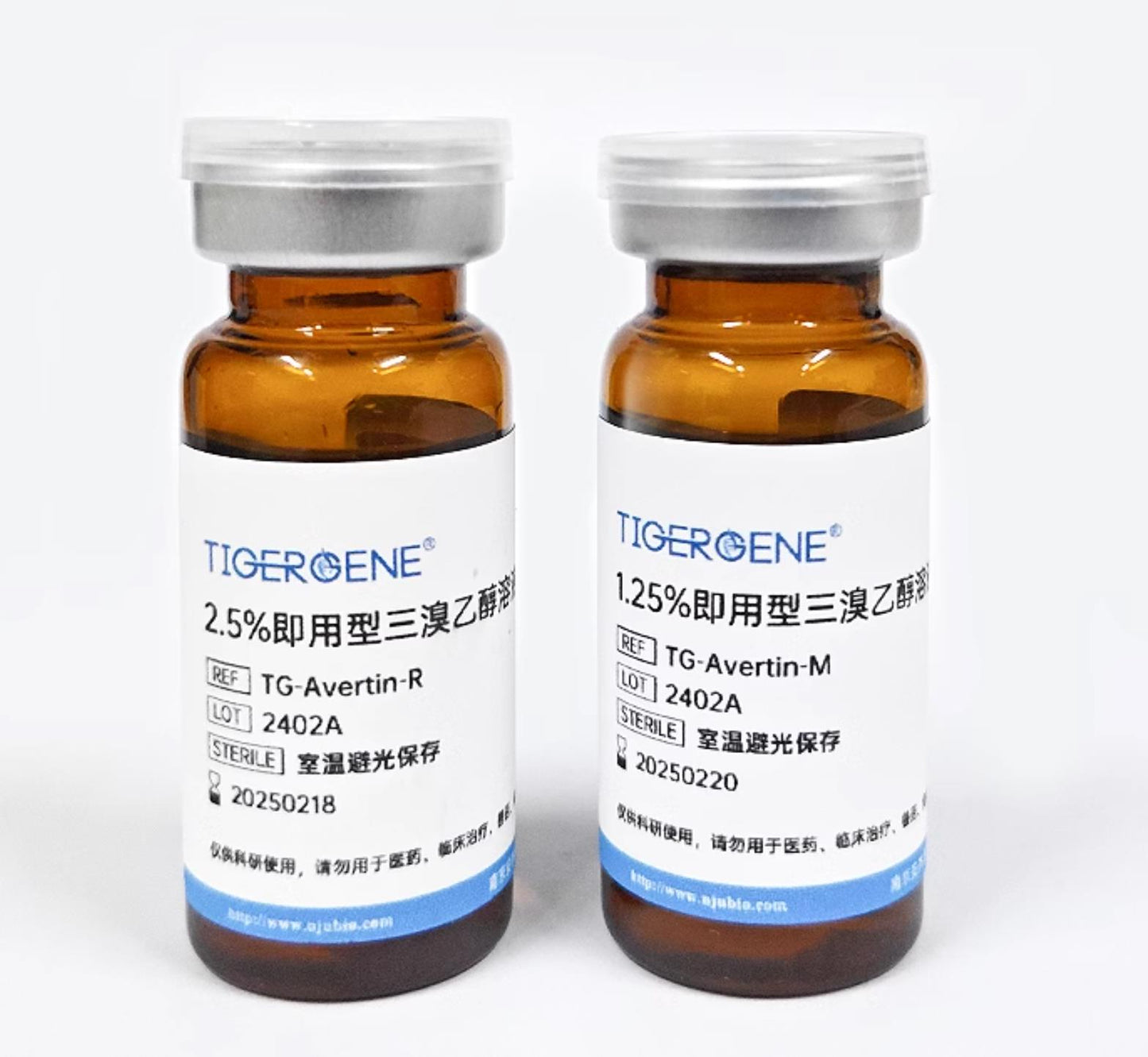Tigergene, Mouse-specific Anesthetic (Tribromoethanol )(Avertin)
Tigergene, Mouse-specific Anesthetic (Tribromoethanol )(Avertin)
A stock of 100% avertin is prepared by mixing 10 g of 2,2,2-tribromoethyl alcohol (Aldrich T4,840-2) with 10 ml of tert-amyl alcohol (Aldrich 24,048-6). Make sure it is fully dissolved (heat to 50°C; use a microwave oven or magnetic stirrer overnight). (Note: If 2,2,2-tribromoethanol is dark in color, it should be recrystallized before use; see below). To use, dilute 100% stock to 1.2-2.5%, v/v, in water or isotonic saline, stirring vigorously until it is dissolved. Filter-sterilize through 0.2-micron filter (filtering also removes remaining undissolved crystals). Both the 100% stock and working solutions are stored in the dark at 4°C to prevent decomposition to the irritant by-products, dibromoacetic aldehyde and hydrobromic acid (Papaioannou and Fox 1993). The working solution is stable for a couple of months, but some labs prefer to prepare it fresh from stock aliquots immediately prior to the experiment.
Ready-to-use 1.25%, v/v, working solution may be prepared by mixing 2.5 g of 2,2,2-tribromoethanol with 5 ml of tert-amyl alcohol and dissolving it in 200 ml of water using a magnetic stirrer. The administration of more dilute solutions of the compound may be recommended because higher concentrations seem to be more frequently associated with postanesthetic mortality (Flecknell 1993). The pH of final working solution should be >5; it is considered toxic if pH is <5.
The proper dose of tribromoethanol (125-250 mg/kg body weight) may vary with different preparations and should be redetermined each time a new 100% stock is made or a working solution has been stored for more than 2 months. To test, inject several mice with doses ranging from 0.014 to 0.018 ml (2.5%) per gram of body weight. The typical dose for 1.25% solution is 0.02 ml per gram of body weight. The dose should be sufficient to give complete anesthesia, but it is also important to check the health and survival of the mice for 3-4 days after¬ward. With some batches of 2,2,2-tribromoethanol, the mice may become sick and die several days after being anesthetized. Recrystallizing the 2,2,2-tribro-moethanol usually solves this problem (see below).
There are conflicting reports in the literature regarding the use of tribro¬moethanol. It has been reported to cause acute peritoneal inflammation and fib¬rinous serositis of the abdominal organs (Zeller 1998). However, with minimal precautions to prevent decomposition (storage in the dark at 4°C), Avertin is effective and simple to use; it provides rapid induction and deep surgical anes¬thesia in mice followed by fast postoperative recovery and low morbidity and mortality (Papaioannou and Fox 1993; Weiss and Zimmermann 1999). Numerous transgenic facilities have successfully used Avertin for more than 15 years.
To recrystallize 2,2,2-tribromoethanol (procedure from N. Lonberg, GenPharm Corp., Mountain View, California):
-
1. Dissolve 50 g of 2,2,2-tribromoethanol in 500 ml of boiling petroleum ether (petroleum ether, NOT ethyl ether-do not use ethyl ether!!!) or hexane (boiling point 69°C) on a stirring hot plate in a fume hood. Caution: These solvents are extremely flammable; exercise extreme caution.
-
2. Add a full spatula of charcoal.
-
3. Filter through fluted filter paper in a glass funnel preheated to 65°C into a second beaker or flask. Cool on ice to 30°C.
-
4. Pour off the supernatant.
-
5. Break up crystals with a glass rod or metal spatula and dry thoroughly under vacuum overnight. Store at 4°C.
无法加载取货服务可用情况
500 件存货
查看完整详细信息

